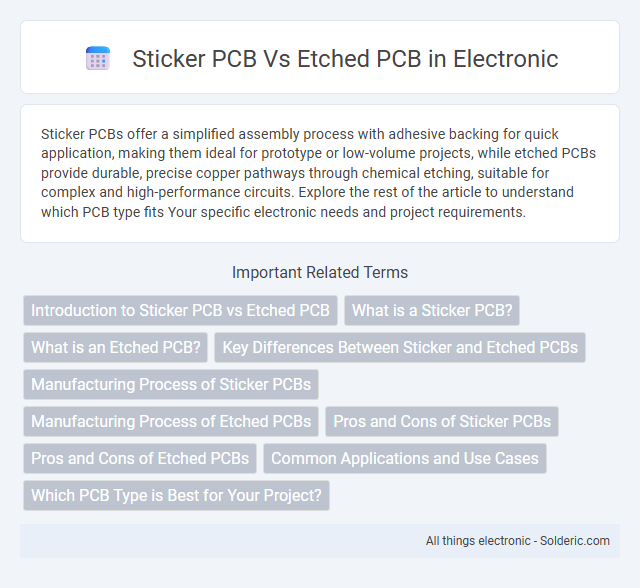Sticker PCBs offer a simplified assembly process with adhesive backing for quick application, making them ideal for prototype or low-volume projects, while etched PCBs provide durable, precise copper pathways through chemical etching, suitable for complex and high-performance circuits. Explore the rest of the article to understand which PCB type fits Your specific electronic needs and project requirements.
Comparison Table
| Feature | Sticker PCB | Etched PCB |
|---|---|---|
| Manufacturing Process | Adhesive-based copper sticker application | Chemical etching of copper-clad laminate |
| Cost | Low-cost, ideal for prototypes and education | Higher cost, suitable for mass production |
| Precision | Lower precision, limited to simple layouts | High precision, supports complex circuits |
| Durability | Less durable, prone to peeling and wear | Highly durable, resists wear and corrosion |
| Production Time | Fast, minimal equipment required | Longer, involves multiple processing steps |
| Application | Prototyping, educational projects, simple circuits | Commercial products, complex electronic devices |
Introduction to Sticker PCB vs Etched PCB
Sticker PCBs use adhesive-backed copper foil patterns applied directly onto substrates, enabling rapid prototyping and flexible circuit designs. Etched PCBs rely on chemical processes to remove unwanted copper from laminate boards, producing durable and precise circuit paths ideal for mass production. Both methods offer unique advantages depending on the complexity, cost, and application of the electronic project.
What is a Sticker PCB?
A sticker PCB is a flexible printed circuit board featuring adhesive backing that allows it to be easily applied to various surfaces, providing a lightweight and thin solution for electronic connections. Unlike etched PCBs, which are rigid and created through chemical etching of copper layers on a substrate, sticker PCBs are designed for simplified installation and conformability in compact or irregularly shaped devices. This type of PCB is commonly used in wearable electronics, flexible displays, and sensor applications requiring reliable yet adaptable circuitry.
What is an Etched PCB?
An etched PCB is a printed circuit board created through a subtractive manufacturing process where unwanted copper is chemically removed from a copper-clad laminate to form the desired circuit patterns. This method ensures high precision and durability, making etched PCBs suitable for complex and high-density electronic applications. The chemical etching process typically uses ferric chloride or ammonium persulfate as etchants to achieve accurate circuitry with excellent conductive pathways.
Key Differences Between Sticker and Etched PCBs
Sticker PCBs feature conductive adhesive layers applied on flexible substrates, enabling easy customization and rapid prototyping with minimal equipment. Etched PCBs involve chemically removing copper from a solid laminate to form precise circuit patterns, offering higher durability and superior electrical performance. The primary differences lie in manufacturing complexity, cost efficiency, flexibility, and long-term reliability.
Manufacturing Process of Sticker PCBs
The manufacturing process of sticker PCBs involves printing conductive ink onto a flexible adhesive substrate, allowing easy application to various surfaces without soldering. This method eliminates the need for complex etching or drilling, reducing production time and costs significantly. Your projects benefit from rapid prototyping and customizable design options inherent in the sticker PCB fabrication process.
Manufacturing Process of Etched PCBs
Etched PCBs undergo a precise chemical etching process where unwanted copper is removed from the board to create the desired circuit patterns, ensuring high accuracy and fine detail. This method involves applying a photoresist layer, exposing it to UV light through a mask, and then chemically dissolving the unprotected copper areas. Your final etched PCB offers superior electrical performance and durability compared to sticker PCBs, which rely on adhesive layers rather than chemical etching.
Pros and Cons of Sticker PCBs
Sticker PCBs offer quick and cost-effective prototyping, making them ideal for low-volume production and simple circuit designs, but they may lack the durability and precision of etched PCBs. Their adhesive backing allows easy application and modification, while limitations include lower heat resistance and potential issues with electrical conductivity over time. Your choice depends on the balance between affordability, ease of use, and the technical requirements of your project.
Pros and Cons of Etched PCBs
Etched PCBs offer high precision and durability due to their well-defined copper pathways and strong adhesion, making them ideal for complex electronic designs with tight tolerances. However, the manufacturing process is time-consuming and costly, involving multiple steps such as etching, drilling, and plating, which can delay production and increase expenses. Environmental concerns also arise from the chemical waste generated during etching, requiring proper disposal and compliance with regulations.
Common Applications and Use Cases
Sticker PCBs are widely used in rapid prototyping and low-volume electronics projects where flexible and adhesive-backed circuits are required, such as wearable devices and custom sensor patches. Etched PCBs are favored for mass production in complex electronic systems, including consumer electronics, automotive control units, and industrial machinery due to their durability and precision. Your choice depends on whether you prioritize quick application and flexibility or long-term reliability and detailed circuit design.
Which PCB Type is Best for Your Project?
Sticker PCBs offer a quick and cost-effective solution for simple, low-volume projects, providing easy application and customization without the need for complex manufacturing processes. Etched PCBs deliver superior durability, precision, and reliability, making them ideal for high-performance and long-term applications where fine circuit details and robust connections are crucial. Your project requirements for complexity, budget, and longevity determine whether the convenience of sticker PCBs or the professional quality of etched PCBs is the best choice.
sticker PCB vs etched PCB Infographic

 solderic.com
solderic.com